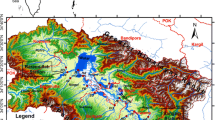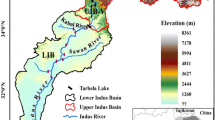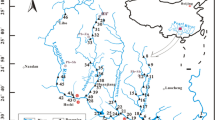Abstract
The Weihe River Basin (WRB), the largest tributary of the Yellow River Basin (YRB), is located in the northwest of China. As the “mother river” of the Guanzhong Plain, it plays an important role in the development of Guanzhong City Group. Based on pH, electric conductivity (EC), total dissolved solids (TDS), and major ionic concentrations of 227 samples collected from the main stream (MS), northern tributaries (NT), and southern tributaries (ST) of the WRB, we explored spatial differential characteristics of hydrochemistry and their controlling factors, solute sources, and water quality of surface water. The results revealed mildly alkaline pH and much higher TDS values than the global average with mean values of 7.9 and 1037.7 mg L−1, respectively. Except NO3−, the concentrations of major ions in the MS and NT were higher than those of the ST, with similar spatial distribution patterns of Ca2+, Na+, Mg2+, SO42−, and Cl−. Na+ and SO42− were the most dominant cation and anion in the MS and NT controlled by both rock weathering and evaporation-crystallization processes. Ca2+ and HCO3− were the most dominant cation and anion in the ST mainly controlled by rock weathering process. Evaporite dissolution contributed the most to dissolved solutes in the MS and NT, while carbonate weathering dominated dissolved solutes in the ST. These findings were confirmed by the results of correlation matrix, principal component analysis (PCA), stoichiometric plots, and different water types identified as Na-SO4·Cl in the MS and NT, and Ca-HCO3 in the ST. Atmospheric and anthropogenic inputs had a minor effect on the surface water chemistry. However, human activities could not be ignored in the ST accounting for 10.9% of the total dissolved solutes, mainly because of the fertilizer application. And the surface water of the ST was more suitable for irrigation and drinking purposes than that of the MS and NT. Knowledge of our findings could contribute new insights to the solute geochemistry and sustainable management of water resources in the lithologically distinct segments of the WRB and other similar areas.











Similar content being viewed by others
Data Availability
The full dataset that support the findings of this study are available from the corresponding author upon reasonable request.
References
Brennan ST, Lowenstein TK (2002) The major-ion composition of Silurian seawater. Geochim Cosmochim Acta 66(15):2683–2700. https://doi.org/10.1016/S0016-7037(02)00870-0
Cai YP, Huang GH, Yang ZF, Sun W, Chen B (2009) Investigation of public’s perception towards rural sustainable development based on a two-level expert system. Expert Syst Appl 36(5):8910–8924. https://doi.org/10.1016/j.eswa.2008.11.032
Chen JS, Wang FY, Meybeck M, He DW, Xia XH, Zhang LT (2005) Spatial and temporal analysis of water chemistry records (1958–2000) in the Huanghe (Yellow River) basin. Glob Biogeochem Cycle 19:GB3016. https://doi.org/10.1029/2004GB002325
Cheng B, Li HE (2021) A Bayesian network approach for determining optimal ecological base flow of rivers in water shortage areas of Northwest China. Environ Sci Pollut Res. https://doi.org/10.1007/s11356-021-13384-w
Chetelat B, Liu CQ, Zhao ZQ, Wang QL, Li SL, Li J et al (2008) Geochemistry of the dissolved load of the Changjiang Basin rivers: anthropogenic impacts and chemical weathering. Geochim Cosmochim Acta 72(17):4254–4277. https://doi.org/10.1016/j.gca.2008.06.013
Cruz JV, Amaral CS (2004) Major ion chemistry of groundwater from perched-water bodies of the Azores (Portugal) volcanic archipelago. Appl Geochem 19:445–459. https://doi.org/10.1016/S0883-2927(03)00135-5
Dalai TK, Krishnaswami S, Sarin MM (2002) Major ion chemistry in the headwaters of the Yamuna river system: chemical weathering, its temperature dependence and CO2 consumption in the Himalaya. Geochim Cosmochim Acta 66(19):3397. https://doi.org/10.1016/S0016-7037(02)00937-7
Dekov VM, Komy Z, Araujo F, Van PA, Van GR (1997) Chemical composition of sediments, suspended matter, river water and ground water of the Nile (Aswan-Sohag traverse). Sci Total Environ 201(3):195–210. https://doi.org/10.1016/S0048-9697(97)84057-0
Fan BL, Zhao ZQ, Tao FX, Liu BJ, Tao ZH, Gao S et al (2014) Characteristics of carbonate, evaporite and silicate weathering in Huanghe River basin: a comparison among the upstream, midstream and downstream. J Asian Earth Sci 96(15):17–26. https://doi.org/10.1016/j.jseaes.2014.09.005
Gaillardet J, Dupré B, Allegre CJ, Négrel P (1997) Chemical and physical denudation in the Amazon River Basin. Chem Geol 142(3–4):141–173. https://doi.org/10.1016/S0009-2541(97)00074-0
Gaillardet J, Dupré B, Louvat P, Allègre CJ (1999) Global silicate weathering and CO2 consumption rates deduced from the chemistry of large rivers. Chem Geol 159(1–4):3–30. https://doi.org/10.1016/S0009-2541(99)00031-5
Galy A, France-Lanord C (1999) Weathering processes in the Ganges-Brahmaputra basin and the riverine alkalinity budget. Chem Geol 159(1–4):31–60. https://doi.org/10.1016/S0009-2541(99)00033-9
General Bureau of China National Environmental Protection (2002) Environmental Quality Standard for Surface Water GHZB1–1999. National Environmental Protection Standard pp. 4–9.
Gibbs RJ (1970) Mechanisms controlling world water chemistry. Science 170(3962):1088–1090. https://doi.org/10.1126/science.170.3962.1088
Gibbs RJ (1967) The geochemistry of the amazon river system: part I. the factors that control the salinity and the composition and concentration of the suspended solids. Geol Soc Am Bull 78(10):1203–1232. https://doi.org/10.1130/0016-7606(1967)78[1203:TGOTAR]2.0.CO;2
Hu MH, Stallard RF, Edmond JM (1982) Major ion chemistry of some large Chinese rivers. Nature 298:550–553. https://doi.org/10.1038/298550a0
Hua K, Xiao J, Li SJ, Li Z (2020) Analysis of hydrochemical characteristics and their controlling factors in the Fen River of China. Sust Cities Soc 52:101827. https://doi.org/10.1016/j.scs.2019.101827
Jehan S, Khan S, Khattak SA, Muhammad S, Rashid A, Muhammad N (2019) Hydrochemical properties of drinking water and their sources apportionment of pollution in Bajaur Agency, Pakistan. Measurement 139:249–257. https://doi.org/10.1016/j.measurement.2019.02.090
YW Jia H Wang ZW Zhao F Wang XC Li et al (2017) Weihe River ecological flow analysis and regulation practices Science Press Beijing, China 978-7-03-050399-2
Jiang LG, Yao ZJ, Liu ZF, Wang R, Wu SS (2015) Hydrochemistry and its controlling factors of rivers in the source region of the Yangtze River on the Tibetan Plateau. J Geochem Explor 155:76–83. https://doi.org/10.1016/j.gexplo.2015.04.009
Larssen T, Seip HM, Semb A, Mulder J, Muniz IP, Vogt RD et al (1999) Acid deposition and its effects in China: an overview. Environ Sci Policy 2(1):9–24. https://doi.org/10.1016/S1462-9011(98)00043-4
Li ZX, Feng Q, Liu W, Wang TT, Cheng AF, Gao Y et al (2014) Study on the contribution of cryosphere to runoff in the cold alpine basin: a case study of Hulugou River Basin in the Qilian Mountains. Glob Planet Change 122:345–361. https://doi.org/10.1016/j.gloplacha.2014.10.001
Li SY, Ye C, Zhang QF (2017) 11-Year change in water chemistry of large freshwater Reservoir Danjiangkou, China. J Hydrol 551:508–517. https://doi.org/10.1016/j.jhydrol.2017.05.058
Li XY, Ding YJ, Han TD, Sillanpää M, Jing ZF, You XN et al (2020) Seasonal and interannual changes of river chemistry in the source region of Yellow River. Tibetan Plateau Appl Geochem 119:104638. https://doi.org/10.1016/j.apgeochem.2020.104638
Li Z, Li CX, Hua K, Li Z (2019a) Groundwater chemistry characteristics and the analysis of influence factors in the Luochuan Loess Tablelands. Huan Jing Ke Xue 40(8):3559–3567 (In Chinese). https://doi.org/10.13227/j.hjkx.201809131
Li Z, Xiao J, Evaristo J, Li Z (2019b) Spatiotemporal variations in the hydrochemical characteristics and controlling factors of streamflow and groundwater in the Wei River of China. Environ Pollut 254 (Part A):113006. https://doi.org/10.1016/j.envpol.2019b.113006
Liu SY, Huang SZ, Huang Q, Xie YY, Leng GY, Luan JK et al (2017) Identification of the non-stationarity of extreme precipitation events and correlations with large-scale ocean-atmospheric circulation patterns: a case study in the Wei River Basin, China. J Hydrol 548:184–195. https://doi.org/10.1016/j.jhydrol.2017.03.012
Liu J, Chen XQ, Shi W, Chen P, Zhang Y, Hu JM et al (2019) Tectonically controlled evolution of the Yellow River drainage system in the Weihe region, North China: constraints from sedimentation, mineralogy and geochemistry. J Asian Earth Sci 179(1):350–364. https://doi.org/10.1016/j.jseaes.2019.05.008
Lu XW, Li LY, Lei K, Wang LJ, Zhai YX, Zhai M (2010) Water quality assessment of Wei River, China using fuzzy synthetic evaluation. Environ Earth Sci 60(8):1693–1699. https://doi.org/10.1007/s12665-009-0303-2
Meybeck M (1987) Global chemical weathering of surficial rocks estimated from river dissolved loads. Am J Sci 287(5):401–428. https://doi.org/10.1016/0198-0254(87)95902-4
Moon S, Huh Y, Qin JH, Pho NV (2007) Chemical weathering in the Hong (Red) River basin: rates of silicate weathering and their controlling factors. Geochim Cosmochim Acta 71(6):1411–1430. https://doi.org/10.1016/j.gca.2006.12.004
Morse JW, Arvidson RS (2002) The dissolution kinetics of major sedimentary carbonate minerals. Earth-Sci Rev 58(1–2):51–84. https://doi.org/10.1016/S0012-8252(01)00083-6
Pant RR, Zhang F, Rehman FU, Wang GX, Ye M, Zeng C et al (2018) Spatiotemporal variations of hydrogeochemistry and its controlling factors in the Gandaki River Basin, Central Himalaya Nepal. Sci Total Environ 622–623:770–782. https://doi.org/10.1016/j.scitotenv.2017.12.063
Park SC, Yun ST, Chae GT, Yoo IS, Shin KS, Heo CH et al (2005) Regional hydrochemical study on salinization of coastal aquifers, western coastal area of South Korea. J Hydrol 313(3–4):182–194. https://doi.org/10.1016/j.jhydrol.2005.03.001
Piper AM (1944) A graphic procedure in the geochemical interpretation of water-analyses. EOS Trans Am Geophys Union 25(6):914–923. https://doi.org/10.1029/TR025i006p00914
Qin T, Yang PH, Groves C, Chen F, Xie GW, Zhan ZJ (2018) Natural and anthropogenic factors affecting geochemistry of the Jialing and Yangtze Rivers in urban Chongqing, SW China. Appl Geochem 98:448–458. https://doi.org/10.1016/j.apgeochem.2018.10.009
Qu JH, Lu SB, Gao ZP, Li WJ, Li ZP, Yu FR (2017) Research on hydrogeochemical characteristics and transformation relationships between surface water and groundwater in the Weihe River. Hydrol Earth Syst Sci. https://doi.org/10.5194/hess-2017-654
Ran LS, Lu XX, Sun HG, Han JT, Yu RH (2015) Chemical denudation in the Yellow River and its geomorphological implications. Geomorphology 231:83–93. https://doi.org/10.1016/j.geomorph.2014.12.004
Roy S, Gaillardet J, Allègre CJ (1999) Geochemistry of dissolved and suspended loads of the Seine River, France: anthropogenic impact, carbonate and silicate weathering. Geochim Cosmochim Acta 63(9):1277–1292. https://doi.org/10.1016/S0016-7037(99)00099-X
Sarin MM, Krishnaswami S, Dilli K, Somayajulu BLK, Moore WS (1989) Major ion chemistry of the Ganga-Brahmaputra river system: weathering processes and fluxes to the Bay of Bengal. Geochim Cosmochim Acta 53(5):997–1009. https://doi.org/10.1016/0016-7037(89)90205-6
Schoeller H (1965) Hydrodynamique dans le karst Hydrodynamics of karst. Actes du Colloques de Doubronik. IAHS/UNESCO.
Sharif MU, Davis RK, Steele KF, Kim B, Kresse TM, Fazio JA (2008) Inverse geochemical modeling of groundwater evolution with emphasis on arsenic in the Mississippi River Valley alluvial aquifer, Arkansas (USA). J Hydrol 350(1–2):41–55. https://doi.org/10.1016/j.jhydrol.2007.11.027
Sikdar PK, Sarkar SS, Palchoudhury S (2001) Geochemical evolution of groundwater in the Quaternary aquifer of Calcutta and Howrah. India J Asian Earth Sci 19(5):579–594. https://doi.org/10.1016/S1367-9120(00)00056-0
Stallard RF, Edmond JM (1983) Geochemistry of the Amazon: 2. The influence of geology and weathering environment on the dissolved load. J Geophys Res 88(C14):9671–9688. https://doi.org/10.1029/jc088iC14p09671
Su P, Wang XX, Lin QD, Peng JL, Song JX, Fu JX et al (2019) Variability in macroinvertebrate community structure and its response to ecological factors of the Weihe River Basin. China Ecol Eng 140:105595. https://doi.org/10.1016/j.ecoleng.2019.105595
Tipper ET, Calmels D, Gaillardet J, Louvat P, Capmas F, Dubacq B (2012) Positive correlation between Li and Mg isotope ratios in the river waters of the Mackenzie Basin challenges the interpretation of apparent isotopic fractionation during weathering. Earth Planet Sci Lett 333–334:35–45. https://doi.org/10.1016/j.epsl.2012.04.023
Tsering T, Abdel Wahed MSM, Iftekhar S, Sillanpää M (2019) Major ion chemistry of the Teesta River in Sikkim Himalaya, India: chemical weathering and assessment of water quality. J Hydrol-Reg Stud 24:100612. https://doi.org/10.1016/j.ejrh.2019.100612
UNEP (2016) A snapshot of the world’s water quality: towards a global assessment. United Nations Environment Programme 162.
Wang WZ, Song JX, Zhang GT, Liu Q, Guo WQ, Tang B et al (2018) The influence of hyporheic upwelling fluxes on inorganic nitrogen concentrations in the pore water of the Weihe River. Ecol Eng 112:105–115. https://doi.org/10.1016/j.ecoleng.2017.12.012
Wang XD, Yang SY, Ran XB, Liu XM, Bataille CP, Su N (2018) Response of the Changjiang (Yangtze River) water chemistry to the impoundment of Three Gorges Dam during 2010–2011. Chem Geol 487:1–11. https://doi.org/10.1016/j.chemgeo.2018.04.006
Wang XX, Su P, Lin QD, Song JX, Sun HT, Cheng DD et al (2019) Distribution, assessment and coupling relationship of heavy metals and macroinvertebrates in sediments of the Weihe River Basin. Sust Cities Soc 50:101665. https://doi.org/10.1016/j.scs.2019.101665
WHO 2017 Guidelines for drinking-water quality: fourth edition incorporating the first addendum World Health Organization Geneva, Switzerland
Wu HW, Wu JL, Li J, Fu CS (2020) Spatial variations of hydrochemistry and stable isotopes in mountainous river water from the Central Asian headwaters of the Tajikistan Pamirs. CATENA 193:104639. https://doi.org/10.1016/j.catena.2020.104639
Xiao J, Jin ZD, Wang J, Zhang F (2015) Hydrochemical characteristics, controlling factors and solute sources of groundwater within the Tarim River Basin in the extreme arid region, NW Tibetan Plateau. Quat Int 380–381:237–246. https://doi.org/10.1016/j.quaint.2015.01.021
Xiao J, Zhang F, Jin ZD (2016) Spatial characteristics and controlling factors of chemical weathering of loess in the dry season in the middle Loess Plateau. China Hydrol Process 30(25):4855–4869. https://doi.org/10.1002/hyp.10959
Xue Y, Song JX, Zhang Y, Kong FH, Wen M, Zhang GT (2016) Nitrate pollution and preliminary source identification of surface water in a semi-arid river basin, using isotopic and hydrochemical approaches. Water 8(8):328. https://doi.org/10.3390/w8080328
Yan JH, Chen JS, Zhang WQ (2021) Study on the groundwater quality and its influencing factor in Songyuan City, Northeast China, using integrated hydrogeochemical method. Sci Total Environ 773:144958. https://doi.org/10.1016/j.scitotenv.2021.144958
Yokoo Y, Nakano T, Nishikawa M, Quan H (2004) Mineralogical variation of Sr–Nd isotopic and elemental compositions in loess and desert sand from the central Loess Plateau in China as a provenance tracer of wet and dry deposition in the northwestern Pacific. Chem Geol 204(1–2):45–62. https://doi.org/10.1016/j.chemgeo.2003.11.004
Zhang SR, Lu XX, Higgitt DL, Chen CTA, Sun HG, Han JT (2007) Water chemistry of the Zhujiang (Pearl River): natural processes and anthropogenic influences. J Geophys Res -Atmos 112:F01011. https://doi.org/10.1029/2006jf000493
Zhang SR, Lu XX, Sun HG, Han JT, Higgitt DL (2009) Major ion chemistry and dissolved inorganic carbon cycling in a human-disturbed mountainous river (the Luodingjiang River) of the Zhujiang (Pearl River). China Sci Total Environ 407(8):2796–2807. https://doi.org/10.1016/j.scitotenv.2008.12.036
Zhang L, Song XF, Xia J, Yuan RQ, Zhang YY, Liu X et al (2011) Major element chemistry of the Huai River basin. China Appl Geochem 26(3):293–300. https://doi.org/10.1016/j.apgeochem.2010.12.002
Zhang B, Song XF, Zhang YH, Han DM, Tang CY, Yu YL et al (2012) Hydrochemical characteristics and water quality assessment of surface water and groundwater in Songnen plain. Northeast China Water Res 46(8):2737–2748. https://doi.org/10.1016/j.watres.2012.02.033
Zhang QQ, Jin ZD, Zhang F, Xiao J (2015) Seasonal variation in river water chemistry of the middle reaches of the Yellow River and its controlling factors. J Geochem Explor 156:101–113. https://doi.org/10.1016/j.gexplo.2015.05.008
Zhang Y, Shi P, Li FD, Wei AL, Song JX, Ma JJ (2018) Quantification of nitrate sources and fates in rivers in an irrigated agricultural area using environmental isotopes and a Bayesian isotope mixing model. Chemosphere 208:493–501. https://doi.org/10.1016/j.chemosphere.2018.05.164
Zhang C, Li J, Zhou ZX, Sun YJ (2021) Application of ecosystem service flows model in water security assessment: a case study in Weihe River Basin, China. Ecol Indic 120:106974. https://doi.org/10.1016/j.ecolind.2020.106974
Zhao YT (2015) Spatial characteristics and changes of soil nutrients in cultivated land of Guanzhong region in Shaanxi Province based on GIS. Doctor Thesis, Northwest A & F University.
Zhu BQ, Yang XP, Rioual P, Qin XG, Liu ZT, Xiong HG et al (2011) Hydrogeochemistry of three watersheds (the Erlqis, Zhungarer and Yili) in northern Xinjiang. NW China Appl Geochem 26(8):1535–1548. https://doi.org/10.1016/j.apgeochem.2011.06.018
Acknowledgements
The authors are thankful to the Northwest Institute of Eco-Environment and Resources, Chinese Academy of Sciences (CAS), for providing us the determination of ionic concentrations.
Funding
This study was supported by the National Natural Science Foundation of China (Grant No. 41771028, 42130516 and 41730751), the National Natural Science Foundation of Shaanxi (2016JM4006), and the Opening Foundation of State Key Laboratory of Continental Dynamics, Northwest University (19LCD04).
Author information
Authors and Affiliations
Contributions
Xiying Dong: conceptualization, sampling, methodology, data curation, statistical analyses, writing–original draft. Liangju Zhao: conceptualization, writing–review and editing, project administration, funding acquisition, supervision. Ninglian Wang: conceptualization, writing–review and editing. Cong Xie: sampling, data curation.
Corresponding author
Ethics declarations
Ethics approval
No need for ethics approval since this work does not include research on identifiable human material or data.
Consent to participate
All the authors agree to participate in this manuscript.
Consent for publication
Not applicable.
Competing interests
The authors declare no competing interests.
Additional information
Responsible Editor: Xianliang Yi
Publisher's note
Springer Nature remains neutral with regard to jurisdictional claims in published maps and institutional affiliations.
Supplementary Information
Below is the link to the electronic supplementary material.
Rights and permissions
About this article
Cite this article
Dong, X., Zhao, L., Wang, N. et al. Spatial variations on the hydrochemistry, controls, and solute sources of surface water in the Weihe River Basin, China. Environ Sci Pollut Res 29, 57790–57807 (2022). https://doi.org/10.1007/s11356-022-19550-y
Received:
Accepted:
Published:
Issue Date:
DOI: https://doi.org/10.1007/s11356-022-19550-y




